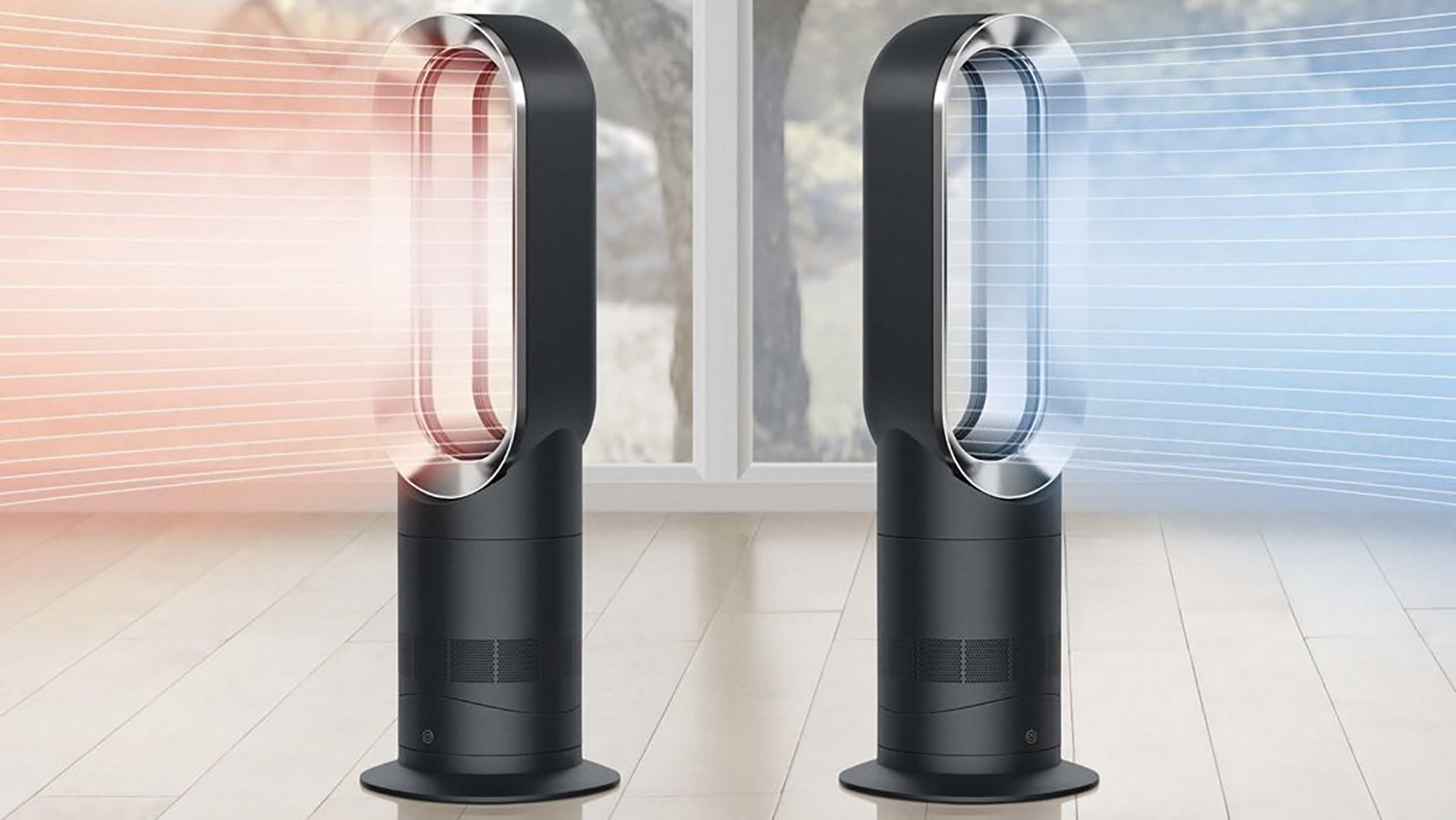Bionaire Double Blade Stand Fan Review
A large fan with lots of airflow
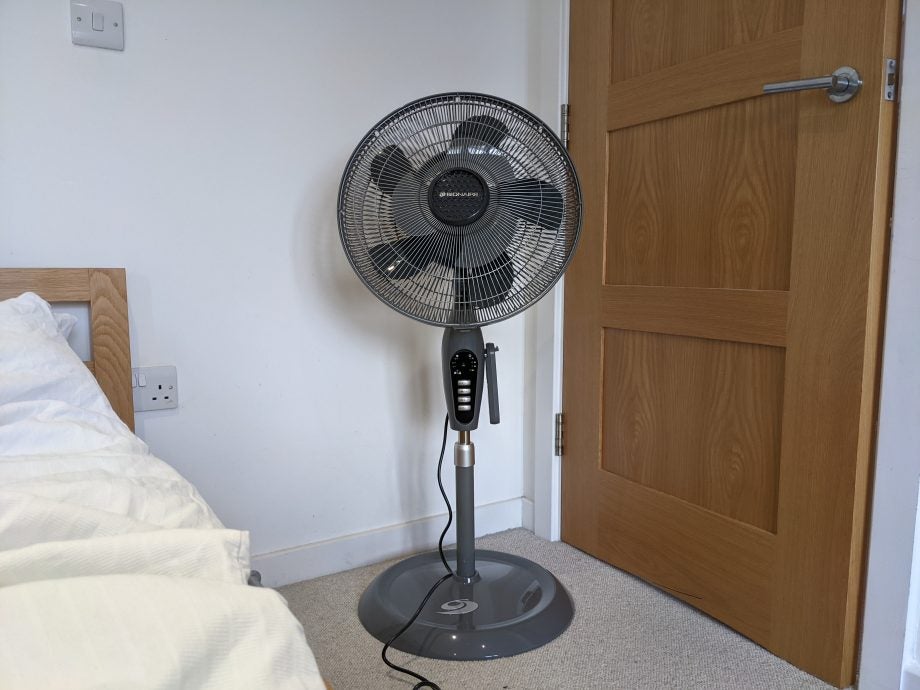
Verdict
Forgive the pun, but the largish Bionaire Double Blade Stand Fan comes with a twist. In front of its 14-inch, five-blade fan, there are three smaller blades. The idea is to create a more powerful airflow, without resorting to a larger main fan. The end result is hardly compact, but the fan can stir up a considerable breeze. Even so, it’s a loud fan and the build quality is a little on the cheap side.
Pros
- Powerful breeze
- Some useful features
Cons
- Moderately noisy
- Plastics feel a little cheap
Availability
- UKRRP: £63
Key Features
- TypeA pedestal fan, this model can be height adjusted between 1000 and 1220mm.
Introduction
The Bionaire Double Blade Stand Fan is a medium-large fan, mounted on an adjustable pedestal. Wider and taller than even the biggest tower fans, it has a fairly large presence in the room. Unusually, there are two sets of blades. The main, rear one has five blades and measures about 14 inches (36cm) across. In front there’s a second three-blade set, measuring roughly 9 inches (23cm). These two blades rotate together to generate a stronger airflow than you’d get from a single 14-inch set of blades.
Aside from the quirky double-blade setup, this is a conventional fan. Its simple control panel offers a smattering of useful features, including an eight-hour sleep timer. This isn’t the quietest fan, however, and its size means it’s better suited to living rooms or offices than generating a quiet breeze at bedtime. This sample was provided by AO.com.
Design and Features
- Design looks dated
- Some useful features
- Slightly tricky assembly
Let’s face it, you wouldn’t buy this fan to impress the neighbours. Like many pedestal fans it has a top-heavy look, and it boasts more shades of grey than a racy novel. Monochrome plastics form the base, control section, motor housing, fan blades and rear guard. They don’t give an impression of quality. Overall, the fan is surprisingly light, but with no carry handle it may be cumbersome for people with limited mobility.
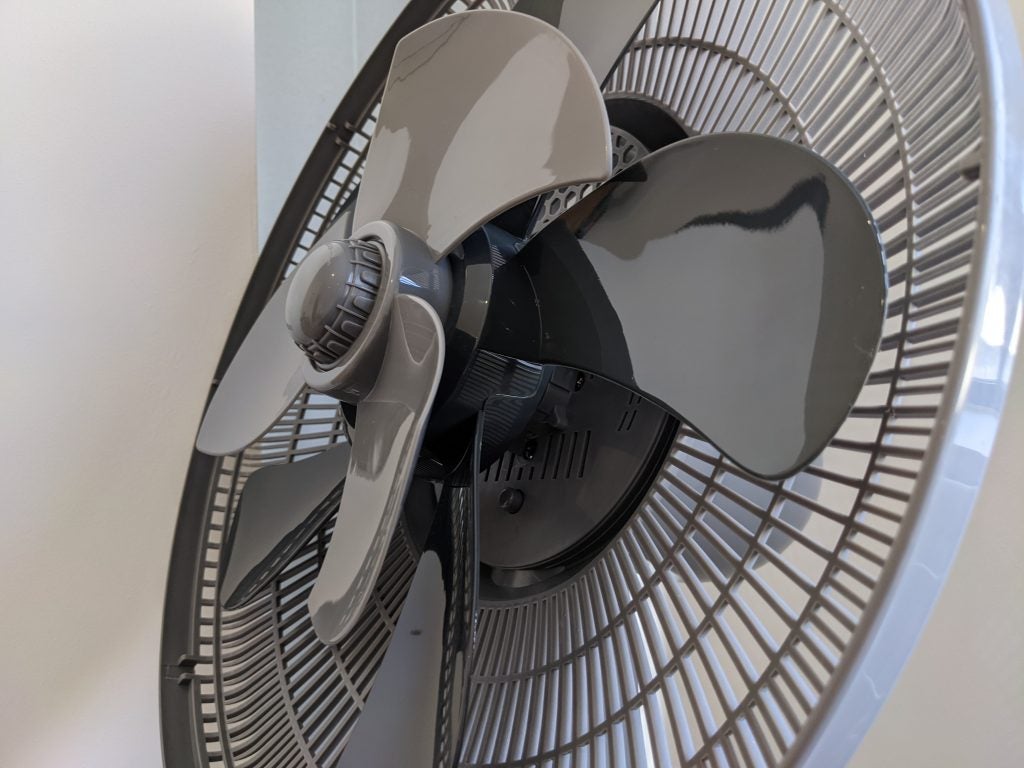
Before you can use it, you have to build it. The Bionaire Double Blade Stand Fan with Remote Control arrives in three main sections, plus the five components that make up the fan and its guard. It isn’t too baffling to fit together, but I struggled to clip the front grille into the lugs on the rear guard.
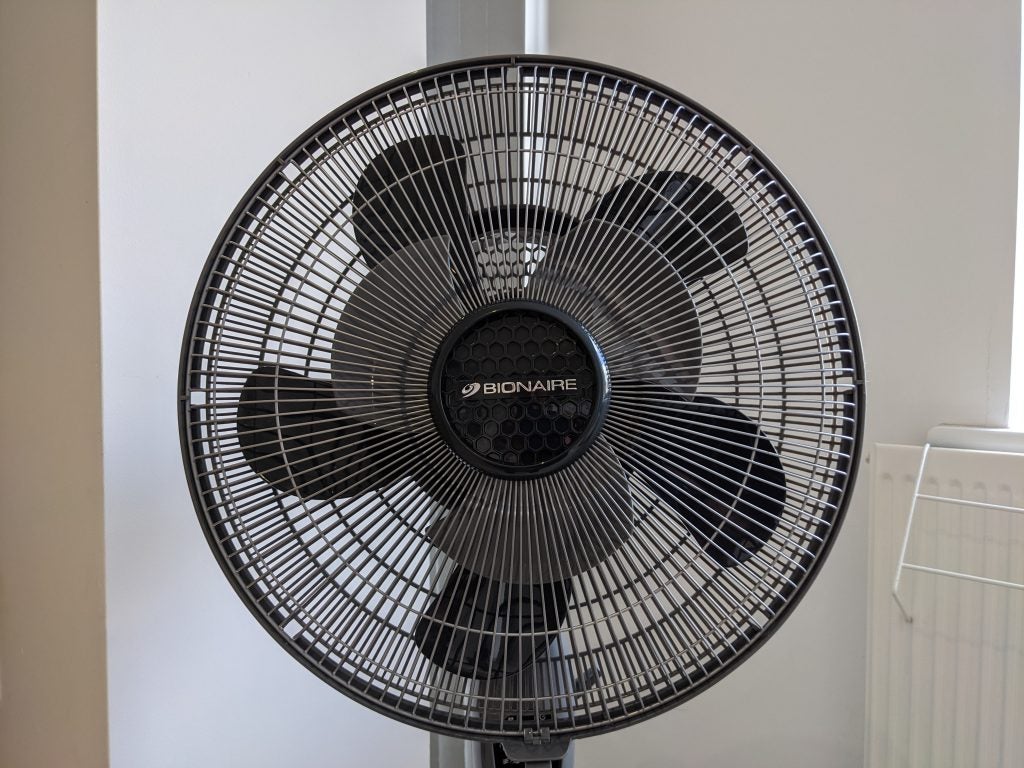
This fan has an electric control panel offering a couple of useful features, beyond the usual on/off and three-speed control. There’s a breeze mode to cycle the fan speed randomly, and a sleep mode that’s meant to cycle it in order – this still appeared random to us. You can set a sleep timer from 1-8 hours, too. There’s a chunky remote providing all the same features, but it arrives without the required pair of AAA batteries.
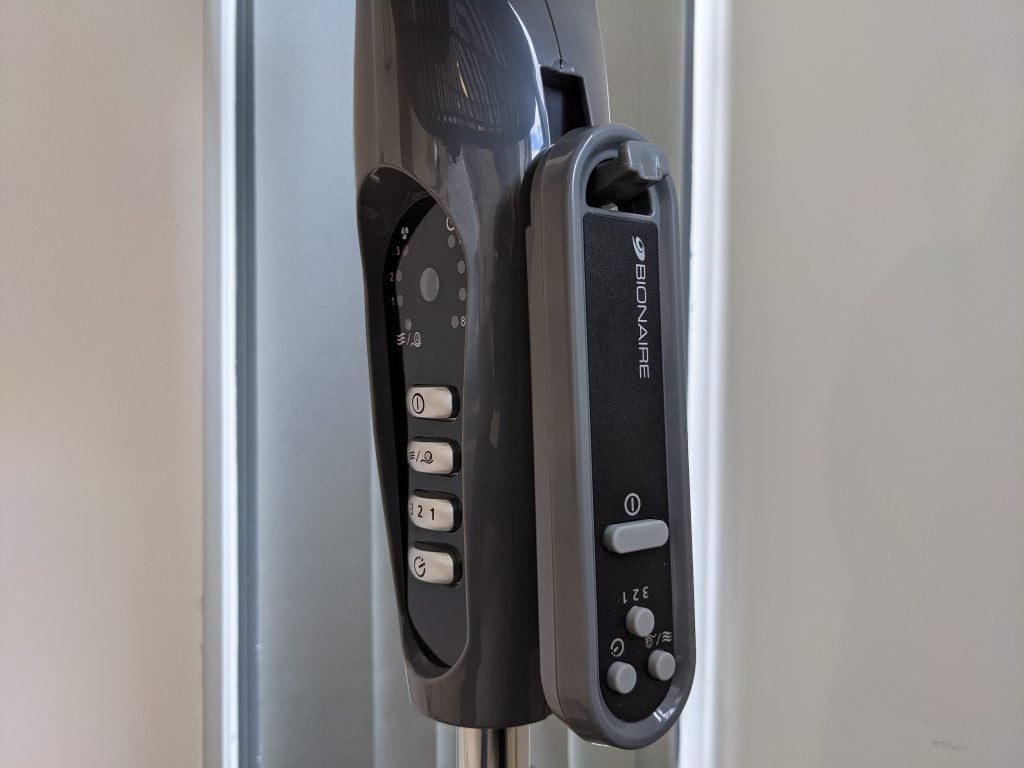
One thing you can’t do from the control panel or remote is activate the horizontal oscillation, which is toggled via a big mechanical button on the rear housing. The fan moves through a 90-degree arc. Manually, you can tilt the head slightly up or downwards, but only through a range of around 30 degrees. The stand telescopes from a total height of about 40 inches (102cm) to 4ft (122cm). Although seemingly stable at the highest position, I’d be wary of letting young kids play around it.
Performance
- Breezy and blustery
- Noisy, but not unpleasantly so
- Moderately high power use
I was eager to find out how effective Bionaire’s dual-blade setup would prove, but the immediate impression was disappointing. Sit 3m in front of this fan and there’s a breeze, but it isn’t as powerful as you’d get from smaller fans such as the Duux Whisper Flex Smart. Move around, however, and you realise that the Bionaire produces a far more diffuse output. Instead of a tight, fast column of air, it creates a sprawling cone of blustery wind.
My measurements back this impression up. At 15cm, I measured powerful wind speeds of 4 metres per second (m/s) on the lowest speed, rising to 5.6m/s at full power. At a 1m distance, this had already dropped to 1.9m/s and 2.7m/s – which is more in line with what I’d expect from a tower fan. At just a 2m distance, sustained wind speeds had dropped below my anemometer’s 0.8m/s minimum. This sells the fan rather short, however: at this remove I could still feel a characteristically blustery breeze over a wide area, with gusts that occasionally prodded the wind meter into life.
In truth, then, this fan does move a lot of air, but it creates a fair amount of noise in the process. The key notes in this are a determined hum from the motor, and a slight whistling of air passing through the wire guard at the front. At speed, the whistle rises, and is joined by a louder ‘blat’ from the blades.
Set to the lowest power, I measured the sound from directly in front at 54dB just 15cm away, and 44dB at 1m. From a right angle – out of the airflow – I measured 42dB and 36dB respectively.
As you’d expect, switching to full power created more noise: I measured 63dB at 15cm and 54dB at 1m. At a right angle, this dropped to 49dB and 44dB respectively. While far from the loudest results we’ve measured, these are all far higher than our top fans. For example, Meaco’s MeacoFan 650 recorded just 43dB and 37dB on this last test.
While discussing noise, it would be remiss not to mention that this fan has an annoying beeper that confirms every control input. You can’t switch it off, making it even less suitable for use in a bedroom or quiet space.
Fans using AC motors invariably consume more power than those with newer DC technology, and that’s the case here. The Bionaire Double Blade Stand Fan with Remote Control consumed 44 watts (W) at minimum speed, rising to 55W at full power. For comparison, the MeacoFan 650 used a maximum of 8W.
Conclusion
If you have plenty of space for a fan, and don’t mind one that makes a fair bit of noise, the Bionaire Double Blade Stand Fan with Remote Control is worth it. It’s quite an effective way to circulate air, even if it produces an irregular buffeting rather than a steady stream. Where other fans have tiny remote controls, this one has a big remote with chunky buttons, which might endear it to people with restricted vision or limited mobility in their hands.
While there’s little else to love about it, this fan is mostly vice-free. It’s not the easiest to assemble, and the result doesn’t look or feel especially classy, but it’s soon overlooked in a large enough room. Its biggest weakness is probably the noise it generates. In a medium-sized room you might need to raise your voice slightly to be heard above it – on the maximum speed, you definitely would.
Overall, this isn’t a bad fan, but it doesn’t particularly stand out – despite a welcome three-year guarantee. If I wanted maximum ventilation, I’d choose Vonhaus’ 18” Matte Black Metal Floor Fan. If I just wanted a good value general-purpose fan, I’d save some money and choose the Vonhaus 35” Tower Fan.
Best Offers
Should you buy it?
If you don’t mind a blustery, big fan, this isn’t a bad choice – especially if you want a remote with bigger buttons.
This isn’t a good choice if you like a focused and consistent blast of air. It’s also too loud for the bedroom, and not especially stylish anywhere else.
Verdict
Forgive the pun, but the largish Bionaire Double Blade Stand Fan comes with a twist. In front of its 14-inch, five-blade fan, there are three smaller blades. The idea is to create a more powerful airflow, without resorting to a larger main fan. The end result is hardly compact, but the fan can stir up a considerable breeze. Even so, it’s a loud fan and the build quality is a little on the cheap side.
FAQs
Yes it does, but it’s a manual switch at the back of the fan.
There’s a larger set of fan blades at the back and a smaller set at the front of the fan head. These work together to increase airflow without dramatically increasing the size of a fan.

